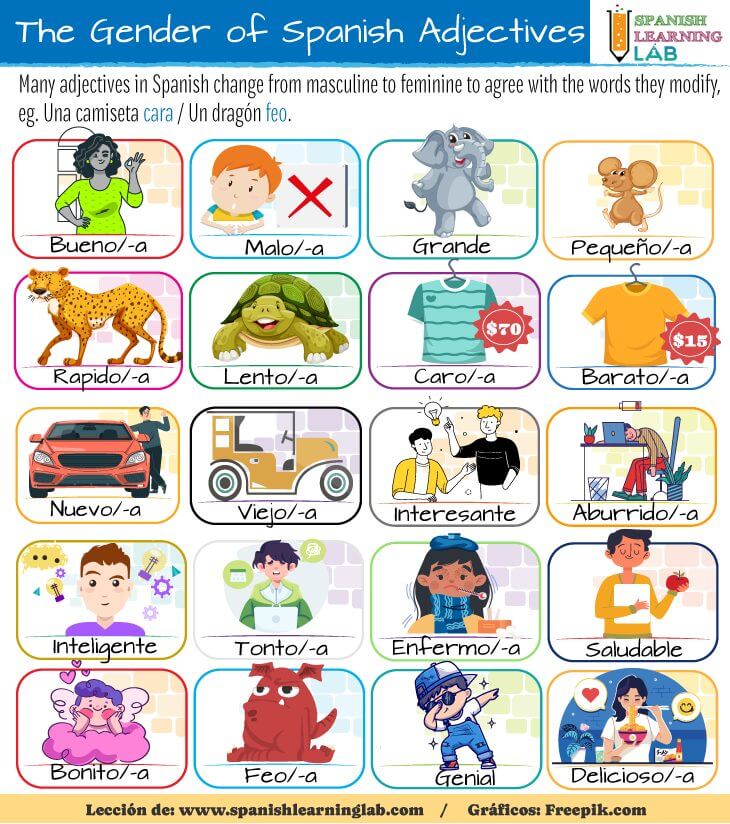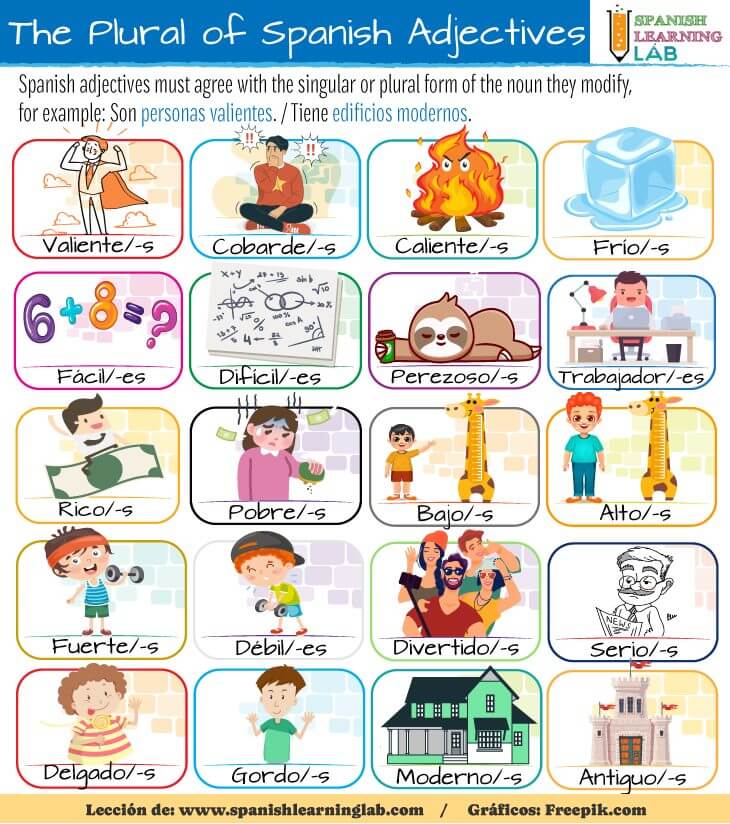In the previous lesson, we explained the rules for adjective placement and talked about the rules to place these words, either before or after nouns. In this lesson, we will learn about another important feature called “concordancia del adjetivo y el sustantivo”, that is Spanish noun-adjective agreement. Do not worry, it will be easier than it sounds, though you will understand everything way faster if you already know the basics about noun gender and the plural form of nouns. Let’s start…
Introductory video: How to use Spanish adjectives
We will begin this lesson with a video explaining the basic rules to use Spanish adjectives. This video was recording in Spanish, but you can also activate the captions (cc) below or check the script. It includes some examples and notes that will be very helpful to understand more about the way adjectives work in the language.
Spanish Adjectives Gender Agreement
Spanish masculine adjectives
Most Spanish adjectives must agree in gender with the noun they modify. When describing a masculine noun like “Amigo” (friend), we must use a masculine adjective such as “Honesto” or at least a neutral like “Inteligente”. Just like with nouns, Spanish masculine adjectives usually end in the vowel -O like “Bonito” and “Creativo”. In addition, some words ending in -R will also be considered masculine adjectives, as shown here:
- El niño es bonito y gordo. (The kid is cute and chubby.)
- El auto es nuevo y espacioso. (The car is new and spacious)
Since both “Niño” and “Auto” are masculine nouns, we must make the adjectives agree with these nouns in Spanish. Otherwise, what we say may sound a bit strange.
Some examples of common masculine adjectives in Spanish are:
Afortunado (lucky), Alto (tall), Bajo (short), Bueno (Good), Estupendo (awesome), Famoso (famous), Malo (bad) and Pequeño (small)
| Carlos es mi amigo. Es el chico alto que está usando un sombrero negro. Carlos is my friend. He is the tall guy who is wearing a black hat. |
| Alberto conoce a un escritor famoso. Sus libros son estupendos. Alberto knows a famous writer. His books are great. |
| Eres muy afortunado. No tienes problema médico. You are very lucky. You have no medical problem. |
Spanish feminine adjectives
On the other hand, when describing feminine nouns like CASA (house), we have to use a feminine adjective like BONITA (pretty) or ESPACIOSA (spacious), and not a masculine one such as BONITO or ESPACIOSO. That being said, Spanish feminine adjectives are the same words with a slight change at the end from -O to -A, e.g. “Bueno” to “Buena”, for example:
- Su novia es muy simpática. (His girlfriend is very nice.)
- ¡Gracias! La comida estuvo deliciosa. (Thank you! The food was delicious.)
Pay attention to a list of common adjectives in Spanish and check how some of them would change their gender from masculine to feminine, e.g. “Bueno” -> “Buena”. Those ending in -E generally won’t need any change to agree with nouns as they are neutral, something we will explain further later.

Know that it is possible to make some masculine adjectives feminine in Spanish by adding -A at the end when the word ends in a consonant, but not in all cases, e.g. “Trabajador/Trabajadora” (correct) and “Popular/Populara” (incorrect). Most nationalities do suffer gender changes too, including some that end in consonants like “español->española”. Read and listen to these sample sentences:
|
Marcos compró una casa nueva. Es muy hermosa y espaciosa.
Marcos bought a new house. It is very beautiful and spacious.
|
|
María es la chica alta que está sentada en el sofá verde.
Maria is the tall girl sitting on the green sofa.
|
|
La ciudad que visitamos tenía una arquitectura única y famosa.
The city we visited had some unique and famous architecture.
|
Spanish adjectives for both masculine and feminine nouns
Some adjectives are used for both genders despite their ending, especially those that end in -E or in consonants, for example: “un libro interesante”, “un examen fácil”, “un chico optimista/una chica optimista”.
Some common Spanish nouns that won’t suffer gender changes are:
Amable (kind), Difícil (difficult), Fácil (easy), Flexible, Paciente (patient), Verde (green).
Most numbers (except for the number one) will stay the same for masculine or feminine nouns, so you could say “Cuatro perros” or “Cuatro casas” and that would be totally correct. However, the number “UNO” will change to UN when used before a masculine noun as in “Un gato“, and to “UNA” before a feminine noun as in “Una amiga”. In this scenerario, UN/UNA would be used as indefinite articles.
| Ella tiene una casa grande / El telescopio es grande. She has a big house / The telescope is big. |
| La casa azul es la más antigua. / Usaremos ese líquido azul. The blue house is the oldest. / We’ll use that blue liquid.. |
| Ella encontró cuatro perlas. / Él ha finalizado cuatro proyectos. She found four pearls. / He has completed four projects |
Interactive quiz: Choose the best Spanish adjective to complete each sentence
Making Spanish adjectives agree with plural nouns
As we mentioned above, Spanish adjectives normally have a singular and a plural form. The rules are exactly the same used to form the plural of nouns. To illustrate this, read these two sentences carefully:
- Ella es una modelo hermosa. (She is a pretty model.)
- Ellas son modelos hermosas. (They are pretty models.)
In these two examples, our goal was to make the noun “modelo” agree with the Spanish adjective “hermoso”, but since “Modelo” is always used in masculine form, the subject “Ella” or “Ellas” tell us we need a feminine adjective. As for the plural form, the subject of the sentence tells us if we are talking about one or many objects, and that help us decide if we must use a singular or plural adjective too. Notice that all the words, including the verb SER, will change so that there is actual noun-adjective agreement in Spanish and to have a fully functional sentence.
Pay attention to the following group of common adjectives in Spanish and how we could form their plural in the language.

Here is a last group of sample sentences showing how we must make adjectives agree with nouns in Spanish so that our sentences are functional and truly express our thoughts:
| Él es un niño inteligente / Ellos son niños inteligentes. He is a smart kid / They are smart kids. |
|
Es un empresario exitoso. / Son empresarios exitosos.
He is a successful businessman. / They are successful businessmen.
|
|
Él es mi mejor amigo. / Nosotros somos mejores amigos.
He is my best friend. / We are best friends..
|
|
Ella es una señora amable. / Las señoras de allá son muy amables.
She is a kind lady. / The ladies over there are very kind.
|
|
La ciudad es impresionante. / Las ciudades que visitamos son impresionantes
The city is impressive. / The cities we visited are impressive
|
Interactive quiz: Making Spanish adjectives agree with nouns
Related Spanish Worksheets:
- Possessive Adjetives in Spanish – PDF Worksheet
- Singular and Plural Nouns in Spanish – PDF Worksheet
- Spanish Nouns Gender and Number – PDF Worksheet
- Definite Articles in Spanish – PDF Worksheet
- Indefinite Articles in Spanish – PDF Worksheet
